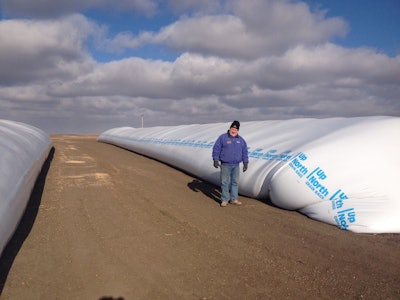
As farming operations grow larger and yields continue their climb higher, many commercial grain facilities are faced with the challenge of handling higher volumes. In a lot of cases, the only solution is to pile grain on the ground, due to a lack of fixed storage. However, one South Dakota co-op, tired of dealing with the spoilage from exposed grain, started thinking outside the bin for a new flexible storage solution.
With headquarters in Ipswich, SD, North Central Farmers Elevator (NCFE) is a full-service co-op with 20 locations. It provides grain handling, agronomy, petroleum, and farm supply products and services to more than 2,500 producer-members in north central South Dakota and south central North Dakota.
Since its original roots dating back to 1915, NCFE has enjoyed the benefits of serving a rich farming area and, as a result, has grown significantly with current annual sales reaching $875 million. During the latest boom in agriculture, however, some of the fixed storage facilities at NCFE locations have found it especially difficult to keep up with the high volumes of grain that farmers are selling.
For the Wecota, SD, facility in particular, the elevator had a tough time unloading and loading grain trucks quickly enough to meet demand. “We have very limited dumping capacities with the old elevator here,” said Doug Roggow, Wecota location manager. “As farming operations and combines get bigger, you’ve got to have faster equipment to accommodate them.”
Due to the storage constraints, the Wecota facility piled much of its grain on the ground. Over the winter, the pile would be exposed to several feet of snow, and in the spring the facility would experience loss due to spoilage.
A solution surfaces
Eventually, one of Roggow’s patrons told him about a grain bagging system that one of the largest farming operations in the area used. He believed that the same grain bagging solution would work for North Central, and encouraged Roggow to take a look.
After receiving the referral, Roggow visited the farmer to see his grain bagging equipment, which was a GrainLogix system from Loftness. It consisted of one machine to load grain into 12-foot-diameter polyethylene bags and another machine to unload grain from the bags. “Our facility has used a different type of 10-foot bagging system in the past, and we had limited success with it,” said Roggow. “But the 12-foot system from Loftness appeared to be much more efficient and user-friendly.”
A demonstration was set up with representatives from Loftness to get a better idea of how grain bags could work for the co-op.
“I had my boss with me for the demonstration, and we saw how fast it was,” said Roggow. “We could see it was better than anything we had tried before.”
Because the demonstration was so successful, Roggow spoke with NCFE operations manager Dave Dohman and general manager Mike Nickolas about purchasing the new equipment for the Wecota location. Given the obvious benefits of the 12-foot system, it didn’t take long to get approval to buy the grain bag loader and unloader.
Success at last
That fall, Roggow began putting the grain bag loader into full use, and he had farmers dump their grain into the loader’s swing-away auger as they came in from the field. “We had excellent results with it,” he said. “Farmers could get in and out quickly, and that’s exactly what they want.”
Compared with Wecota’s fixed storage, which unloads 900 bushels in approximately 15 minutes, the new grain bagging system can unload an 1,800-bushel trailer in only seven to eight minutes. Roggow said, “Farmers really like to dump in it because it is so quick.”
NCFE primarily stores corn in its grain bags, although the co-op has also used the bags for sunflowers and spring wheat.
“The grain bagging system is a pretty good deal for spring wheat to protect it from rain throughout the summer,” said Roggow. “Otherwise, you could get 5 to 6 inches of rain on your wheat pile, and you’ve got a mess.”
The co-op has also experienced success storing higher moisture corn in bags. “We’re told it can store corn up to 22% moisture, but we normally aim for 18% to 20%,” said Roggow. “If we can hit an average target of 20%, it’s perfect.”
After several months when Roggow is ready to unload the bags, he has experienced that the grain comes out in the same condition in which it was loaded.
The airtight bag provides a dry, sealed environment in which the oxygen level is reduced, and the concentration of carbon dioxide is increased.
This environment prevents any insect problems or fungal diseases, while slowing down the grain’s natural metabolic process.
One key factor to achieving optimal grain condition is the bag itself. Using a high-quality bag helps ensure a safe environment for the grain and maintain its value. Roggow stresses the importance of this as a way to protect his inventory, especially when commodity prices are high and every bushel is worth a lot of money.
To unload the bags, NCFE uses its grain bag unloader to transfer grain from the bags into a trailer at up to 24,000 bushels/hour.
Because of this fast unloading ability, the Wecota facility has also become popular with commercial grain haulers.
“They used to hate hauling for us because it took so long to load a truck,” said Roggow. “Now, they don’t have any issues when they hear they’re going to Wecota. In fact, I’ve had truckers hauling 1,800-bushel trailers tell me that our location is the fastest they’ve ever loaded.”
Return on investment
Today, Roggow stores much of his grain in bags. In fact, the Wecota location handles between 1.8 and 2.2 million bushels and can hold approximately 620,000 bushels in fixed storage and 300,000 bushels in bagged storage. This added volume has been the main factor in achieving a quick return on investment from the grain bagging system, which can store grain for as little as 7 cents/bushel.
“It’s a great profit-to-expense ratio,” said Roggow. “We can take in a lot more bushels than we could before, and the bags help protect our inventory quality.”
When Roggow isn’t using the grain bag loader and unloader, he lets other NCFE locations borrow them, or he rents them out to area farmers. But when harvest rolls around, he makes sure the grain bagging equipment is in his hands, ready to go.
“I’m excited about it because my farmers are excited about it,” he said. “It makes me look good, and it makes us look good as a company. It’s a heck of a harvest tool.”














